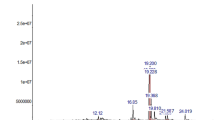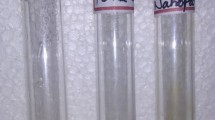Abstract
Dusky cotton bug Oxycarenus hyalinipennis Costa (Hemiptera: Lygaeidae) is a serious polyphagous pest of cotton including other crops. To consider the necessities of growing world population, the use of pesticides have been increased which have resulted insect resistance besides several side effects. Dusky cotton bug (DCB) like other pests also showed resistance to most of the pesticides. To overcome the adverse effects of pesticides, scientists have diverted their attention to develop an ecofriendly approach to combat harmful pest. Nanotechnology is considered as an alternative and an innovative technique for pest control strategy. In the current study characterizations of Azadirachta indica based green synthesized silver nanoparticles (AiAgNPs) have been carried out to investigate the toxicity against 4th, 5th nymphal instars and adult DCB. The AiAgNPs were synthesized by standard protocol and characterized by using various techniques like UV-Vis spectrum, Dynamic light scattering (DLS), Zeta potential, Fourier Transform Infra Red (FTIR) spectrometer, Scanning as well as Transmission Electron Microscopy which confirmed the AiAgNPs biosynthesis. Tukey’s HSD test revealed that AiAgNPs nanoformulation at 1250 ppm showed maximum mortality against DCB 4th instar (38.42, 69.21 and 91.95%) followed by 5th instar (34.14, 60.98 and 84.40%) and adult (27.76, 53.88 and 83.15%) post exposure period of (24,48 and 72 h) respectively for each DCB stage as compared to other concentrations used. Probit analysis showed LC50 of tested AiAgNPs 376.04, 485.60 and 560.23 for the 4th, 5th nymphal instars and adult DCB respectively after 72 h post exposure which was positively correlated with older one. The biogenic AiAgNPs proved to be most effective compound and can be used successfully ecofriendly way in IPM program for the management of dusky cotton bug.







Similar content being viewed by others
Data availability
On convincing demand, the corresponding author will provide all data and materials described in the manuscript available.
References
Abbott WS (1925) A method of computing the effectiveness of an insecticide. J Econ Entomol 18(2):265–267
Ahmed R, Nadeem I, Yousaf MJ, Niaz T, Ali A, Ullah Z (2015) Impact of dusky cotton bug (Oxycarenus laetus Kirby) on seed germination, lint color and seed weight in cotton crop. J Entomol Zool Stud 3(3):335–338
Ahmed S, Saifullah, Ahmad M, Swami BL, Ikram S (2016) Green synthesis of silver nanoparticles using Azadirachta indica aqueous leaf extract. J Radi Res Appl Sci 9(1):1–7
Akter S, Huq MA (2020) Biologically rapid synthesis of silver nanoparticles by Sphingobium sp. MAH-11T and their antibacterial activity and mechanisms investigation against drug-resistant pathogenic microbes. Arti cells. Nanomed Biotech 48(1):672–682. https://doi.org/10.1080/21691401.2020.1730390
Asimuddin M, Shaik MR, Adil SF, Siddiqui MR, Alwarthan A, Jamil K, Khan M (2020) Azadirachta indica based biosynthesis of silver nanoparticles and evaluation of their antibacterial and cytotoxic effects. J King Saud Uni-Sci 32(1):648–656. https://doi.org/10.1016/j.jksus.2018.09.014
Bao Y, He J, Song K, Guo J, Zhou X, Liu S (2021) Plant-extract-mediated synthesis of metal nanoparticles. J. Chem 2021. https://doi.org/10.1155/2021/6562687
Benelli G (2018) Mode of action of nanoparticles against insects. Environ Sci Pollut Res 25:12329–12341. https://doi.org/10.1007/s11356-018-1850-4
Benelli G, Lukehart CM (2017) Applications of green-synthesized nanoparticles in pharmacology, parasitology and entomology. J Clust Sci 28:1–2. https://doi.org/10.1007/s10876-017-1165-5
Bernardes MFF, Pazin M, Pereira LC, Dorta DJ (2015) Impact of pesticides on environmental and human health. Toxicol studies-cells drugs Environ 8:195–233. https://doi.org/10.5772/59710
Chen X, Schluesener HJ (2008) Nanosilver: a nanoproduct in medical application. Toxicol Lett 176:1–12. https://doi.org/10.1016/j.toxlet.2007.10.004
Chowdhury A, Ara J, Islam MS (2021) Green synthesis of Phytochemical Nanoparticles and their antimicrobial activity, a review study. Biomed J Sci Tech Res 34(4):26929–26935. https://doi.org/10.26717/BJSTR.2021.34.005580
Devi GD, Murugan K, Selvam CP (2014) Green synthesis of silver nanoparticles using Euphorbia hirta (Euphorbiaceae) leaf extract against crop pest of cotton bollworm, Helicoverpa armigera (Lepidoptera: Noctuidae). J Biopest 7:54
Dono D, Hidayat Y, Suganda T, Hidayat S, Widayani NS (2020) The toxicity of neem (Azadirachta indica), citronella (Cymbopogon nardus), castor (Ricinus communis), and clove (Syzygium aromaticum) oil against Spodoptera frugiferda. CROPSAVER-J Plant Prot 3(1):22–30. https://doi.org/10.24198/cropsaver.v3i1.28324
Dube P, Meyer S, Madiehe A (2020) Antibacterial activity of biogenic silver and gold nanoparticles synthesized from Salvia africana-lutea and Sutherlandia frutescens. Nanotechnol 31(50):505607
Finney DJ (1971) Probit Analysis, 3rd edn. Cambridge University Press, Cambridge. (ISBN 052108041X. OCLC 174198382)
Galatage ST, Hebalkar AS, Dhobale SV, Mali OR, Kumbhar PS, Nikade SV, Killedar SG (2021) Silver Nanoparticles: Properties, Synthesis, Characterization, Applications and Future Trends. In Silver Micro-Nanoparticles-Properties, Synthesis, Characterization, and Applications. London: IntechOpen 61–80. https://doi.org/10.5772/intechopen:92480
Gill HK, Garg H (2014) Pesticide: environmental impacts and management strategies. Pesti-toxic aspec 8:187. https://doi.org/10.5772/57399
Hafeez F, Akram M, Farooq M, Saghir M, Arshad M, Iftikhar A, Naeem-Ullah U (2020) Dusky cotton bug Oxycarenus hyalinipennis Costa (Lygaeidae: Hemiptera) loss assessment in cotton. Inter J Tropic Insect Sci 41(2):1163–1167
Ijaz M, Shad SA (2021) Risk of resistance and cross resistance development to selection with imidacloprid and level of heritability in Oxycarenus hyalinipennis Costa (Hemiptera: Lygaeidae): a potential pest of cotton. Phytoparasitica 49(2):287–297. https://doi.org/10.1007/s12600-020-00842-3
Iqbal J, Bhutta SA, Alqarni AS, Owayss AA, Ansari MJ (2018) Seasonal population dynamics of dusky cotton bug (Oxycarenus spp.) in transgenic cotton varieties under field conditions. Saudi J Biol Sci 25(6):1122–1127
Jafir M, Ahmad JN, Arif MJ, Ali S, Ahmad SJN (2021) Characterization of Ocimum basilicum synthesized silver nanoparticles and its relative toxicity to some insecticides against tobacco cutworm, Feb.(Lepidoptera; Noctuidae). Ecotoxicol Environ Safety 218:112–278. https://doi.org/10.1016/j.ecoenv.2021.112278
Kannan M, Uthamasamy S, Mohan S (2004) Impact of insecticides on sucking pests and natural enemy complex of transgenic cotton.Current Sci726–729
Majeed B, Farooqi MA, Rasul A, Sagheer M, Ali Q, Akhtar ZR (2021) Green Synthesis of Silver Nitrate Nanoparticles from Camelina Sativa (L.) and its effect to Control Insect Pests of stored grains. Int J Tropic Insect Sci 41(4):3031–3039. https://doi.org/10.1007/s42690-021-00495-7
Nguyen DH, Lee JS, Park KD, Ching YC, Nguyen XT, Phan VH, Hoang Thi TT (2020) Green silver nanoparticles formed by Phyllanthus urinaria, Pouzolzia zeylanica, and Scoparia dulcis leaf extracts and the antifungal activity. Nanomaterials 10(3):542. https://doi.org/10.3390/nano10030542
Panda MK, Dhal NK, Kumar M, Mishra PM, Behera RK (2021) Green synthesis of silver nanoparticles and its potential effect on phytopathogens. Materials Today: Proceedings 35:233–238. https://doi.org/10.1016/j.matpr.2020.05.188
Poopathi S, De Britto LJ, Praba VL, Mani C, Praveen M (2015) Synthesis of silver nanoparticles from Azadirachta indica a most effective method for mosquito control. Environ Sci Pollution Res 22(4):2956–2963. https://doi.org/10.1007/s11356-014-3560-x
Prasannaraj G, Venkatachalam P (2017) Green engineering of biomolecule-coated metallic silver nanoparticles and their potential cytotoxic activity against cancer cell lines. Adv Nat Sciences: Nanosci Nanotech 8(2):025001
Rajeshkumar S (2016) Synthesis of silver nanoparticles using fresh bark of Pongamia pinnata and characterization of its antibacterial activity against gram positive and gram negative pathogens. Reso-Efficient Technol 2(1):30–35. https://doi.org/10.1016/j.reffit.2016.06.003
Rasool S, Raza MA, Manzoor F, Kanwal Z, Riaz S, Iqbal MJ, Naseem S (2020) Biosynthesis, characterization and anti-dengue vector activity of silver nanoparticles prepared from Azadirachta indica and Citrullus colocynthis. Royal Soc open sci 7(9):200–540. https://doi.org/10.1098/rsos.200540
Roni M, Murugan K, Panneerselvam C, Subramaniam J, Nicoletti M, Madhiyazhagan P, Canale A (2015) Characterization and biotoxicity of Hypnea musciformis synthesized silver nanoparticles as potential eco-friendly control tool against Aedes aegypti and plutella xylostella. Ecotoxicol Environ Saf 121:31–38. https://doi.org/10.1016/j.ecoenv.2015.07.005
Saeed R, Abbas N, Razaq M, Mahmood Z, Naveed M, Rehman HMU (2018) Field evolved resistance to pyrethroids, neonicotinoids and biopesticides in Dysdercus koenigii (Hemiptera: Pyrrhocoridae) from Punjab. Pakistan Chemosphere 213:149–155. https://doi.org/10.1016/j.chemosphere.2018.09.042
Saeed R, Razaq M, Abbas N, Jan MT, Naveed M (2017) Toxicity and resistance of the cotton leaf hopper, Amrasca devastans (distant) to neonicotinoid insecticides in Punjab, Pakistan. Crop Protec 93:143–147. https://doi.org/10.1016/j.cropro.2016.11.032
Salem MSED, Mahfouz AY, Fathy RM (2021) The antibacterial and antihemolytic activities assessment of zinc oxide nanoparticles synthesized using plant extracts and gamma irradiation against the uro-pathogenic multidrug resistant Proteus vulgaris. Biometals 34(1):175–196. https://doi.org/10.1007/s10534-020-00271-z
Schaefer CW, Panizzi AR (2000) Economic importance of Heteroptera: a general view. In Heteroptera Econ Impor 25–30: CRC Press
Senthilkumar SR, Sivakumar T (2014) Green tea (Camellia sinensis) mediated synthesis of zinc oxide (ZnO) nanoparticles and studies on their antimicrobial activities. Int J Pharm Pharm Sci 6(6):461–465
Shahid M, Naeem-Ullah U, Khan WS, Saeed S, Razzaq K (2022) Biocidal activity of green synthesized silver nanoformulation by Azadirachta indica extract a biorational approach against notorious cotton pest whitefly, Bemisia tabaci (Homoptera; Aleyrodidae). Int J Trop Insect Sci 1–12. https://doi.org/10.1007/s42690-022-00771-0
Soares MA, Passos LC, Campos MR, Collares LJ, Desneux N, Carvalho GA (2019) Side effects of insecticides commonly used against Tuta absoluta on the predator Macrolophus basicornis. J Pest Sci 92(4):1447–1456. https://doi.org/10.1007/s10340-019-01099-4
Some S, Bulut O, Biswas K, Kumar A, Roy A, Sen IK, Ocsoy I (2019) Effect of feed supplementation with biosynthesized silver nanoparticles using leaf extract of Morus indica L. V1 on Bombyx mori L.(Lepidoptera: Bombycidae). Sci Rep 9(1):1–13. https://doi.org/10.1038/s41598-019-50906-6
Srinivas M, Patil BV (2004) Quantitative and qualitative loss caused by dusky cotton bug, Oxyacarenus laetus Kirby on cotton. Karnataka J Agric Sci 17(3):487–490
Sweet MH (2000) Seed and chinch bugs (Lygaeoidea). Heteroptera of economic importance, 143–264
Tag HM, Saddiq AA, Alkinani M, Hagagy N (2021) Biosynthesis of silver nanoparticles using Haloferax sp. NRS1: image analysis, characterization, in vitro thrombolysis and cytotoxicity. AMB Express 11(1):1–12. https://doi.org/10.1186/s13568-021-01235-3
Ukkund SJ, Ashraf M, Udupa AB, Gangadharan M, Pattiyeri A, Marigowda YK, Puthiyllam P (2019) Synthesis and characterization of silver nanoparticles from Fuzarium oxysporum and investigation of their antibacterial activity. Mater Today: Proc 9:506–514. https://doi.org/10.1016/j.matpr.2018.10.369
Ullah S, Shad SA, Abbas N (2016) Resistance of dusky cotton bug, Oxycarenus hyalinipennis Costa (Lygaidae: Hemiptera), to conventional and novel chemistry insecticides. J Econ Entomol 109(1):345–351. https://doi.org/10.1093/jee/tov324
USDA. Pest Alert Cotton Seed Bug (Oxycarenus hyalinipennis) Program Aid No (2059) United States Department of Agriculture, Animal and Plant Health Inspection Service, Plant Protection and Quarantine, 2010, 5
Yadav J, Jasrotia P, Bhardwaj AK, Kashyap PL, Kumar S, Singh M, Singh GP (2021) Nanopesticides: current status and scope for their application in agriculture. Plant Protec Sci 58(1):1–17. https://doi.org/10.17221/102/2020-PPS
Acknowledgements
The MNS-University of Agriculture, Multan provided the research facilities needed to carry out the present experiment, for which the authors are quite grateful. The Higher Education Commission (HEC) of Pakistan, which provided funding for Indigenous 5000 PhD fellowship, and the supervisory committee deserve special gratitude for their insightful comments and suggestions.
Funding
Higher Education Commission (HEC) and MNS-University of Agriculture, Multan, Punjab, Pakistan, have provided funding.
Author information
Authors and Affiliations
Contributions
MJ carried out the experiments, collected and reared DCB, collected and analyzed the data, and wrote the manuscript. UN designed and supervised the experiments, provided technical direction; WSK provided the manuscript a critical reading for intellectual gratification. MAQ, SS and MAK reviewed and approved the final manuscript.
Corresponding author
Ethics declarations
Competing interests
The authors claim to have no conflicts of interest.
Additional information
Publisher’s note
Springer Nature remains neutral with regard to jurisdictional claims in published maps and institutional affiliations.
Rights and permissions
Springer Nature or its licensor (e.g. a society or other partner) holds exclusive rights to this article under a publishing agreement with the author(s) or other rightsholder(s); author self-archiving of the accepted manuscript version of this article is solely governed by the terms of such publishing agreement and applicable law.
About this article
Cite this article
Javaid, M., Naeem-Ullah, U., Khan, W.S. et al. Characterization of Azadirachta indica synthesized silver nanoparticles and its toxicity against Dusky cotton bug, Oxycarenus hyalinipennis Costa (Hemiptera:Lygaeidae). Int J Trop Insect Sci 43, 463–473 (2023). https://doi.org/10.1007/s42690-023-00953-4
Received:
Accepted:
Published:
Issue Date:
DOI: https://doi.org/10.1007/s42690-023-00953-4




